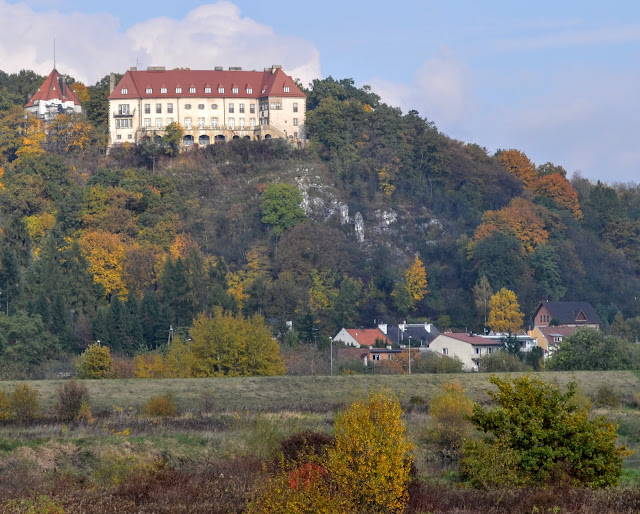Przegorzały/Zinar Castle - History, Food, Fresh Air with a Fabulous View
 |
| Przegorzały Castle - Willa Tower to the left and Schloss Wartenberg on the right situated on Skałki (crag) Przegorzalskie. Viewed from the cycle path on the south of the Vistula River If you are tired of trudging the cobbled streets in the city,and are desperate for some fresh air and a wonderful view, then you could do worse than take a trip to Przegorzały Castle (zamek) - now known as Zinar Castle. Access is easy, take the number 134 (destination the Zoo) from the Blonia. Alternatively, walk along to the Cracovia football stadium and take the 409 bus, or, if you feel like some exercise, you can walk to it. The castle is situated in an area which reads on the map as Las Wolski. Although this sounds like a dodgy salsa dance that people would do in the 1980s at weddings, this is in fact a large area of deciduous woodland still within the urban confines of Krakow. As mentioned already, the zoo is housed here, but there are other sights of note for the intrepid visitor, and Zinar Castle is most definitely one of these. To be perfectly honest, the castle itself is better viewed not in the woods at all, but from the cycle/walking trails along the Vistula River. However, you will not be disappointed by the views from its terraces with panoramic vistas to the river below, the south-western part of Krakow, the undulating forested lumps of the Beskidy mountains, and – if it is a clear day - to the jagged peaks of the Tatra Mountains beyond. Coupled with this you have a lovely café/restaurant to dine in or simply have a cuppa and admire the views. To be clear though – this is not a castle in the sense of most because there are no rooms, dungeons, thrones or torture chambers to visit. In fact, you can’t access most of the building as what once housed the Jagiellonian University's Institute of European Studies, and also the Centre for Holocaust Studies, has now been turned into a 5 star hotel.
Las Wolski in autumnWhat is truly fascinating is the history of castle. There are essentially two parts to it. Firstly there is the sightly older Willa Tower constructed in the 1920s by Adolf Szyszko-Bohusz who had been director of renovation crew of the Wawel Castle, went on to be director of the Department of Antique Architecture at the Academy of Fine Arts in Krakow (subsequently its rector), and then Director of the Architecture Department at the Warsaw University of Technology. A renowned architect, he named Willa Tower his "Belvedere" due to its superb views - it was also his family home. However, things take a more sinister turn after the Nazi invasion of 1939. The evil Baron Otto von Wächter arrived on the scene. As a reward for participation in the Nazi coup in Austria he was given the title of Governor of the District of Krakow and subsequently the District of Galicia. He was an Austrian lawyer, member of the SS and this role as an Alderman entitled him to a town house. He chose a pretty stunning building called the Palace Under the Rams on the Old Town square (which now houses the famous Piwnica pod Baranami). For Otto though, this was not enough. Like Hitler himself, he obviously fancied his very own "Eagles Nest" rural retreat and had his eye firmly on the Willa Tower with its prominent position on Skałki (crag) Przegorzalskie. Szyszko-Bohusz obviously had no intentions of giving up his family home, so the Nazis confiscated it and had him arrested on a trumped up charge. Otto then decided this tower was not grand enough to suit his needs and proceeded to have an entire castle constructed next to it in 1941. It was called Schloss Wartenberg and was modelled on the castles of the German Rhineland. Clearly no expense was spared on its construction with its elegant facades and terraces. Baron Otto von Wächter was less admirable unfortunately. His signature is on decrees ordering the expulsion of the 68,000 Krakow Jews, the formation of the ghetto and the death of over 100,000 Polish civilians under his rule as Governor of the District of Galicia. In addition, he oversaw the slaughter of 1000 Polish resistance fighters who lie buried close to the castle in a mass grave known locally as Glinik. Despite a request being sent to the Military Governor of the United States Zone after the war that Wachter be returned to Poland for trial for his part in deportations, executions and mass murder, he managed to slip away. It is documented that he actually was given refuge in 1949 in the Vatican by a pro-Nazi Austrian bishop named Alois Hudal. However, in that same year he died from kidney disease, allegedly poisoned by jaundice picked up when swimming, or - perhaps it was karma. In the days after the liberation of Krakow by the Red Army, the castle became a hospital, research institute for the Ministry of Forestry and then finally allocated to the Jagiellonian University by the communist authorities. Adolf Szyszko-Bohusz attempted to reclaim the castle but failed.
Las Wolski and the Camaldolese MonasteryA visit to this area could include a yomp around the marked trails in the Las Wolski forest or a visit the Pilsudski Mound or Camaldolese Monastery. I am not a fan of zoos so I am not going to recommend it despite it being in a lovely location. Visitors can access the restaurant and cocktail bar. Both offer a lovely terraces and panoramic views. Hotel i restauracja z unikalnym widokiem w Krakowie - Zinar Castle The map below will help you locate Zinar Castle. |




Nice! I love when people are happy about spending their time in Poland :) Makes me so happey :)
ReplyDelete